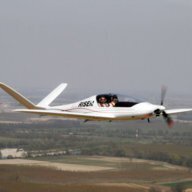-
Posts
798 -
Joined
-
Last visited
-
Days Won
7
Content Type
Profiles
Forums
Gallery
Downloads
Blogs
Events
Store
Aircraft
Resources
Tutorials
Articles
Classifieds
Movies
Books
Community Map
Quizzes
Posts posted by SSCBD
-
-
RF - you must remember theses aircraft (RAA LSA) are not tested to the degree of absolutes. Nor are the specs and quoted figures can be relied on by some manufactures in this sector.
As we have seen Boeing stuffs up a lot and they have thousands of qualified engineer's that still get it wrong.
Don't try to push the envelope as it might bite you with SSCBD = Stall - Spin - Crash -Burn -Die!
-
 2
2
-
-
Sling 2 - Weights for a Sling 2 100hp Rotax injected
Maximum take-off weight 600kg
Empty Weight 380 kg
Useful load 220 kg
Assuming 100 litre of fuel at .72 kg per l = 72kg.
So 220 kg useful load – LESS - 72 kg fuel (100l) gives a max fuel t/off load available of 148 kg
Say (not being rude - more than a few of us are 100kg ish.
Then I have a Pax say 77kg or up. (Some friends are more)
Plus I usually carry some stuff in the back for example tie downs – headsets – I always have a iPad pro and take a couple litres of water – flight bag stuff, etc. So let’s guess at 7 kg of stuff. (If camping in the back blocks it would be more in real life)
EXAMPLE
EMPTY WEIGHT SLING 2 OF 380KG
100L FUEL 72KG
PILOT AND PAX 177KG (weight this trip)
STUFF IN BACK 7KG
Current - TAKEOFF WEIGHT 636KG -36KG OVERWEIGHT
ALSO
If I take my mate who is heavy at 113 KG (he checked on scales last time – now on diet) I am "only" 77kg overweight!!!!! (IF I FLEW WITH FULL FUEL). BUT THEN I WOULD HAVE NO FUEL, IF I TOOK FUEL OUT.
(Of course, before the comments, I also know take-off distance, stall speed, climb rate etc is affected including adding hot and high density alt) AND C of G. I can take fuel out but what if you have a long flight out and no refuel ability. I know the should plan but its not the question of have YOU flown overweight?
The Sling 2 is rated for 700KG MTOW overseas so aircraft is rated for it.
And so is the RAA Jab 230 I believe is at 760kg as a four seat VH version.
So the question stands who has not flown overweight. (in a past life).
-
Yes power lines in field
-
Nice power lines running across the end.
-
1 hour ago, facthunter said:
Constant speed props DO mask torque loss. A torquemeter is a very complex thing and hard to organise, IF your prop can go so fine as to create negative thrust you will not be able to maintain flight if that happens accidently. There's a whole new world of issues you bring into the equation with variable pitch props. There is a distinct safety aspect to a lot of them as well as cost and weight.. I love them when they are there on a plane that justifies it..Like particularly turbines where obviously the engine will not take fixed pitch in the starting cycle. . without some problems. Nev
FT A lot of CSU's are being fitted to RAA LSA aircraft these days specifically with Rotax engines. My Question is why I cant see any on GEN4 engines.
And as I stated - the performance increase Quoted by - Airmaster Propellers CSU state that:
Performance tests have shown up to:
• 33% shorter ground roll
• 10% better climb than fixed pitch prop
• 20% improvement in cruise and economy
Also provided was an Endorsement Specifically J430 which is the 4 seat VH version
Sohrab Ghasimi - Jabiru J430There were some significant improvements in performance as follows: 20-30% reduction in ground roll, Higher climb rate, Smoother running and an increase of cruise speed to of 15 - 20%.
PDF from Airmaster of above information.
http://www.gap.aero/pdf/airmaster/Airmaster_propeller-systems-332-420.pdf
SO if you operate in say far nth QLD and tight strips in a Jab 230 for example - and you had the money WHY NOT Have the extra performance.
-
 1
1
-
-
May I suggest you are missing my point, of the performance increase in takeoff distance / roll including reduced - not floating on landing. It is the Aussie Summers with density altitude and tight strips that makes this system attractive with a fully loaded Jab 230 - if the performance increase reported is correct, which I would expect from other LSA aircraft i have flown with CSU. But I have zero information on the Jab 230 and the gen4 3300 engine real time increase. Any Jab owners can put any light on why?
-
Airmaster Propellers CSU state that:
Performance tests have shown up to:
• 33% shorter ground roll
• 10% better climb than fixed pitch prop
• 20% improvement in cruise and economy
Also provided was an Endorsement Specifically J430 which is the 4 seat VH version
Sohrab Ghasimi - Jabiru J430There were some significant improvements in performance as follows: 20-30% reduction in ground roll, Higher climb rate, Smoother running and an increase of cruise speed to of 15 - 20%.
PDF from Airmaster of above information.
http://www.gap.aero/pdf/airmaster/Airmaster_propeller-systems-332-420.pdf
SO THE QUESTION
Why don’t Jab offer this option? To me its a huge increase of (not being rude) a sluggish Jab 230 specifically looking at HOT 30c plus weather and short strips.
Yes it costs a lot - 8k but worth it in my opinion for a 30% ish, take off distance reduction.
From Jab 230 quoted seal level etc
Roll of 226m
To 50ft 354m
So in my head 30% reduction takeoff is 100m, so 250m ish to 50 ft.
Yes I have GA and LSA CSU in other aircraft but cant find any exact reason for Jab 230D not having them as option.
If correct the cruise speed increase of 15to 20% would push the Jab right up to the VNE of 140kts but still can be managed.
ALSO
As those who know and fly CSU equipped, GA or RAA planes when you select landing mode or push the blue lever its like a brake dragging or slowing the aircraft.
This would also decrease the float and landing roll.
So anyone know of other Jabs with CSU or why the factory won’t put them on as a option. It a option I would put on after anyway.
-
1 hour ago, RFguy said:
well the windsock will be velocity calibrated. (or should be). not just any old sock in the wind.
RF -You are being tooo rigid - For example Whitsunday airstrip has a windsock at each end of the runway.
Many at time both show opposite wind direction.
You also get an idea of wind strength with a wind sock -BUT what about a gust after you checked the wind sock 15 seconds ago - strength now has changed.
-
If real - just lost for words. How
-
To me which I proceed on a practical way, which is, it all depends on the exact time you are about to land. As you may get a gust which is way more than you can control to land so be ready for an instant go around, or you arrive at touchdown when the wind has dropped before the next gust.
I have enough hours to understand what i am getting into - so be warned for new pilots it can all go wrong - especially in tail wheel aircraft which i have a lower risk for in cross wind limits.
-
-
Well done Uncle Frank.
-
 1
1
-
-
Ah! Veterinary dentistry in the wilds of Northern Canada. Another example of the Hudsons Bay Company looking after natural resources.
[ATTACH type=full" alt="1600514300210.png]56442[/ATTACH]
No try the Whitsundays flying out to the reef. Lost soooo many pairs of ray bans falling off the floats in open sea swell
-
With amphibian beavers and metal props we used metal files to take the water damage out (smooth the dings) of the leading edge. Huge damage on takeoff on water after a number of hours.
-
 1
1
-
-
It all goes out the window with gusts, sink and turbulence from trees on smaller tight strips when you fly by yourself away from your home field that you learn on.
-
 3
3
-
-
Take up gliding

Or turn the engine off.
I know airframe noise.
-
A drone with 40 grenades and rigged to release is cheap way to carpet bomb. Average cost in bulk - being about $200 per round and weight is 400g each.
-
WOW
-
The quoted cabin noise of a Jab is 95db.
Others like Sling and Technam I have flown seem to be about the same when you take the headphones off.
Any ideas on how to lower in cockpit noise.
For example any quite aftermarket exhaust systems for rotax or jab engines being made without loss of HP.
Any idea of prop noise level in cruise?
-
RF - The automatic landing system on these RAA aircraft are simple to use - subject to runway or strip length .
To get the auto land system working simply fly the aircraft down to where the wheels are two feet over the runway. Then just hold the two feet height with power off and till speed washes off. The aircraft will land automatically. Simple......
-
 1
1
-
 1
1
-
-
230 for load and space in the back plus speed
-
You sure? - An aircraft developed in Canada for Canadian/North American conditions (may apply to certain parts of Europe as well), where large bodies of fresh water "litter" the landscape. True we could dump salt/sea water on our fires (that's assuming they can "load" in wave condition which I doubts) but who wants salt poisoning of our soils?
They can load salt water in open sea swell (up to 1.5m) as when they put on a show on the Gold Coast 10 years ish ago.
-
This is what we should have had 10 years ago - six of them.
-
 2
2
-
-
Probably this question has been asked before - however - a four point harness with say 3 inch wide chest straps seems without knowing to be common sense in low impart crash (incident) or roll over compared to a thinner (less wide) lap sash.
Has anyone got any medical or specific information on the benefits or problems for or against . Specifically with regard to age of pilots in RAA as we are getting older and bones softer. Reducing the possible injury etc.
I know fitting it in the aircraft has to be correct with angles and attachment points.





SINNERS COME TO CHURCH AGAIN - "WHO HAS NEVER FLOWN OVERWEIGHT" - THESE ARE MY EXAMPLES IN REAL LIFE.
in AUS/NZ General Discussion
Posted
RF - Do you know the way bush pilots check single engine C of G? This is a real question?